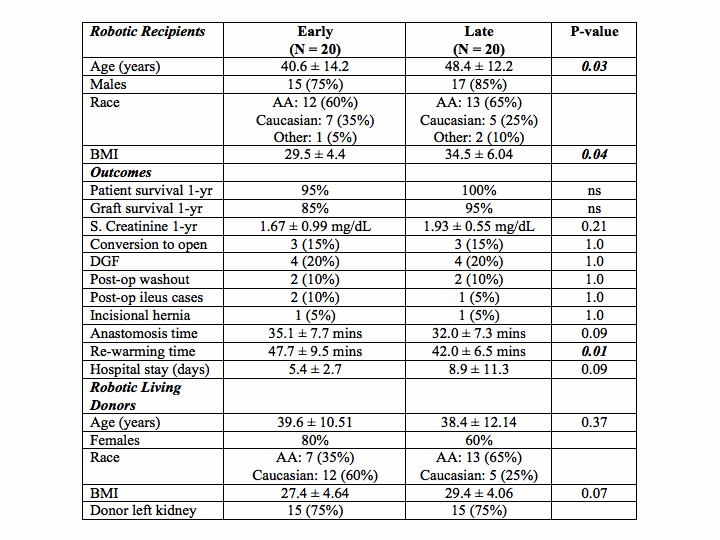Robotic-assisted kidney transplants (RAKT) from living donors: single center experience
Amit Sharma1, Deki Tsering1, Aamir Khan1, Seung Lee1, Daisuke Imai 1, Adrian Cotterell1, Chandra Bhati 2, Marlon Levy1.
1Hume-Lee Transplant Center, Virginia Commonwealth University, Richmond, VA, United States; 2Division of Transplantation Surgery, University of Maryland, Baltimore, MD, United States
Introduction: Obese patients with ESRD may be denied access to life-saving kidney transplant due perceived higher risk of complications. We have adopted Robotic-assisted kidney transplant (RAKT) from living donors as a technique for renal transplantation in this population. We share our experience during our learning curve and compare it with our recently performed RAKTs.
Methods: Consecutive RAKT using kidneys procured with robotic-assisted live donor nephrectomy at our center between June 2018 and August 2021 were retrospectively reviewed and analyzed in two groups: the early (n = 20) versus late (n = 20) experience. Data were compared using student’s t-test and Fisher’s exact test (p < 0.05 significant).
Results: A majority of recipients in both groups (60% vs. 65%) were African Americans (AA). Recipients in our recent experience were significantly older (48.4 ± 12.2 vs. 40.6 ± 14.2, p = 0.03) with higher BMI (34.5 ± 6.04 vs. 29.5 ± 4.4, p = 0.03). There was no difference between the two groups in patient or graft survival or serum creatinine at 1-year post-RAKT. The anastomosis times were not significantly different (35.1 ± 7.7 vs. 32.0 ± 7.3 mins), though the re-warming time (47.7 ± 9.5 vs. 42.0 ± 6.5 mins) was significantly longer in our early experience (p=0.016). There was no significant difference in intra- or post-operative complications. There were no significant differences between the donor age, sex, race, BMI or laterality of the procured kidneys.

Conclusions: Our early and more recent experience demonstrates that RAKT from living donors can be safely performed with excellent outcomes in obese, predominantly African American patients with ESRD. Practice paradigms are evolving to offer RAKT to patients with BMI >40 who may otherwise may not be considered eligible for kidney transplantation.

right-click to download
